Birds, in death, seem more peaceful than mammals. Recently dead, they are unnaturally still, but are beautiful, perfect, almost. In death, birds allow us to observe them as close as we wish, and to absorb all those details we cannot see when they are so lively and far away. For starters, birds are incredibly light. When I first picked up a dead bird, I was amazed by how seemingly weightless it was. It was like the tiny body in my hands had no mass; it was like carrying air. Birds are also very fragile-looking: they have tiny feet with even tinier hooked claws, and their feathers are perfect, so very perfect in the way they cover that tiny body. The plumage interlocks and shines, and those downy feathers are so incredibly soft.
In October of 2009, I spotted a dead sparrow lying in the road. It was a kind of rainy morning, and Stephanie and I continued on to the farmers market to buy our produce for the week. On the way back, the sparrow was still there. This time, I stopped, scooped up the small body, and placed it in my car. Later that day, after the rain had let up, I photographed the sparrow in a parking lot, before laying it to rest at the base of a tree. It was a tiny being -- and a common, hated one, at that. The bird was a juvenile house sparrow, detested in North America for stealing nesting sites from our native birds. I'd never held one before, or seen one so close -- and it was beautiful. The feathers were brown and gray, nothing flashy or fancy, but it was so undeniably perfect.
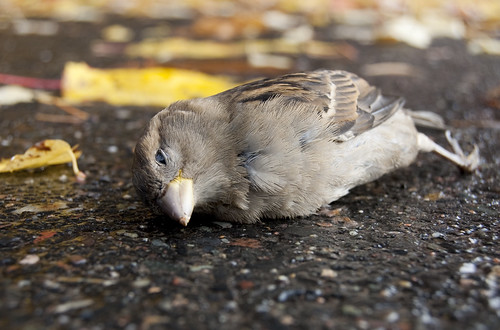
In Marquette, we have a deluge of gulls, both of the herring and ring-billed varieties. They flock over the dumpsters near the grocery stores and dormitories. In the spring, ring-billed gulls gather en masse on Picnic Rocks, where they make their nests. Dead gulls are regular finds on the beach, but I couldn't have prepared myself for what I found in June 2009.
There's a roadside park along Lakeshore Drive, and a few hundred feet out are Picnic Rocks, where the gulls are as thick as blades of grass in a field. Living near this park at the time, Stephanie and I were out for a late-afternoon walk, and I (again), did not have my camera with me. I was looking at the large rocks on the beach when I smelled the unmistakable stench of something dead. It took me a while to find the source, and when I did, I couldn't believe it. It was the tiniest little corpse, reduced almost to a skeleton: it was a dead gull chick. I returned the next day to photograph it.
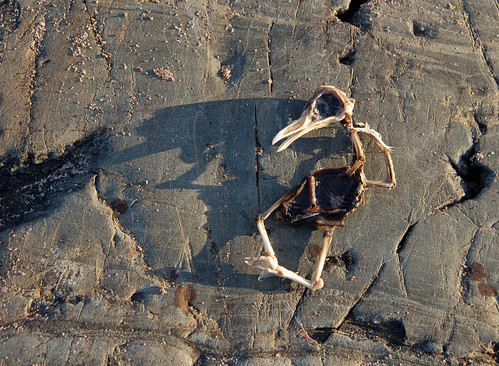
This gull chick, very likely from a nest at Picnic Rocks, was in a state of decay I'd never seen before. Looking at the photograph, it's haunting, almost, with the darkened eye socket and useless-looking wings and legs. The body almost doesn't look like it could possibly be from this earth -- and yet it is. The process of decay can be mysterious and bizarre.
The gull chick wasn't the last dead gull I encountered. Later, in October of that year, we discovered the wings of a gull that had washed up on the far side of Presque Isle (once more, I did not have my camera with me, and I had to drive to the other end of the city to retrieve it). The resulting photograph was far more ambiguous than anything I'd taken before:
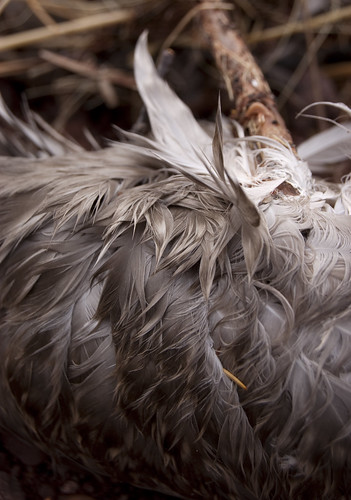
In November, I found the body of a recently-deceased juvenile ring-billed gull on the beach near the working ore dock. Like the house sparrow before it, the gull, so mundane and dull-colored, was so perfect and beautiful, even in death. Its head was tucked peacefully under its body.
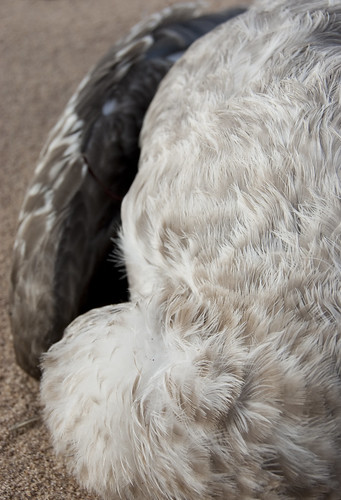 Marquette also has a decent-sized pigeon population. They flock in large groups, both downtown and in the neighborhoods. I've seen their flocks evade eagles and hawks, and it's fascinating to watch so many animals move as one. Earlier this month, as I was driving to Presque Isle Park, I spotted something protruding from a melting snowbank -- the wing of a bird! I decided I'd check it out later. On my way back from the island, I parked, illegally, and quickly removed the bird from the snowbank, not having the time to look at it. I found a parking lot further down on Lakeshore Drive, the one next to the working ore dock, and I decided it'd be a good place to photograph the bird.
Marquette also has a decent-sized pigeon population. They flock in large groups, both downtown and in the neighborhoods. I've seen their flocks evade eagles and hawks, and it's fascinating to watch so many animals move as one. Earlier this month, as I was driving to Presque Isle Park, I spotted something protruding from a melting snowbank -- the wing of a bird! I decided I'd check it out later. On my way back from the island, I parked, illegally, and quickly removed the bird from the snowbank, not having the time to look at it. I found a parking lot further down on Lakeshore Drive, the one next to the working ore dock, and I decided it'd be a good place to photograph the bird.I soon realized it was a pigeon. The body was eviscerated, likely by a bird of prey, and it was missing its head, left leg, and tail. Despite the gore, the pigeon's body really was quite striking. Its feathers, a dull gray, shined in the sunlight, so much that I had to photograph it in the shadow cast by my car. Its remaining foot was fascinating to look at: it was pink and scaly, and the claws looked relatively sharp.

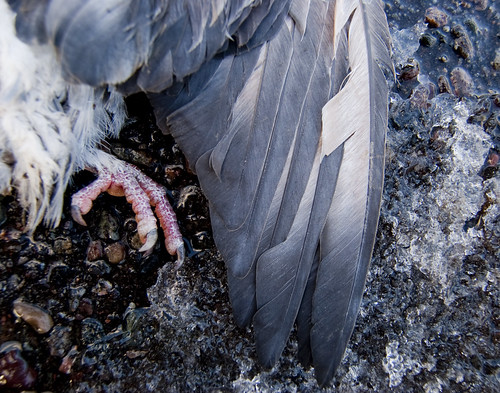
The next time you find a dead bird, don't turn your eyes and nose away. Take a closer look; touch it, if you dare. Even the most common of sparrows is an animal to be revered.




Very nice, Marjorie. I love to read what you write. Mom
ReplyDeleteYour photographs of birds are my favorite out of your study, exactly for the reason you so eloquently state in your introduction.
ReplyDeleteEvery one of these images are stunning and beautifully composed.
@Mom
ReplyDeleteThanks..
@Molly
Thank you! They're definitely my favorite. The one problem I find is that dead birds, being as tiny as they are, are so hard to come back to and photograph again a week or even just a few days later - they disappear much faster than a dead deer.
This comment has been removed by the author.
ReplyDelete